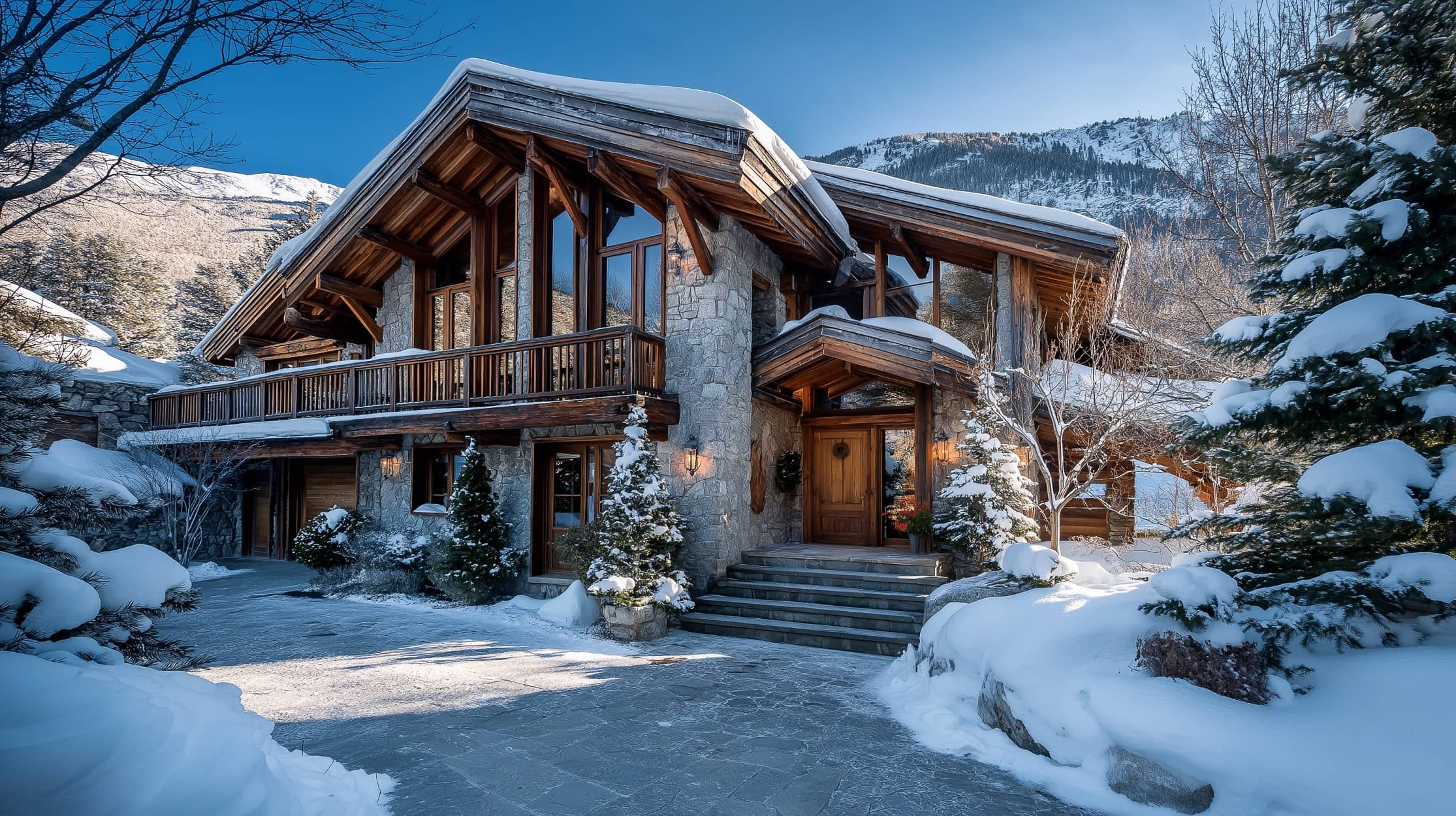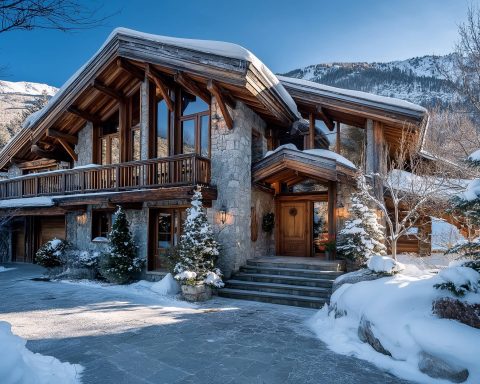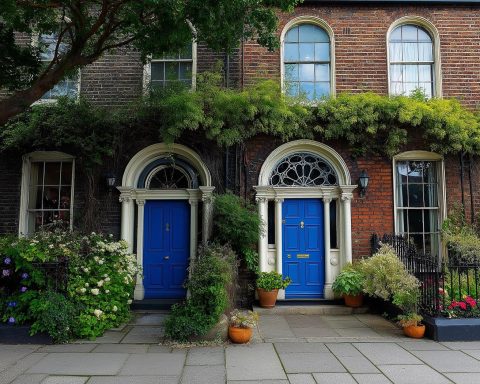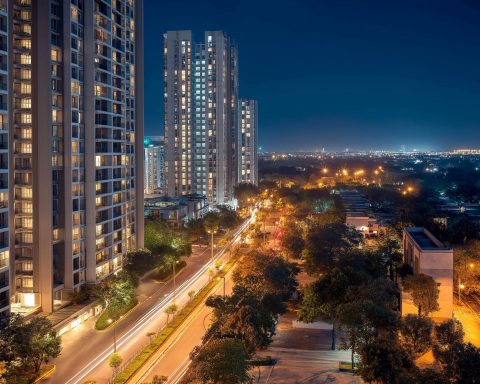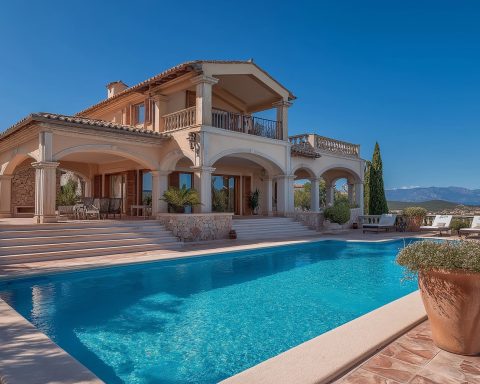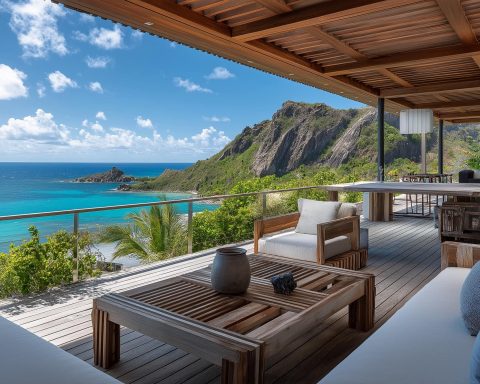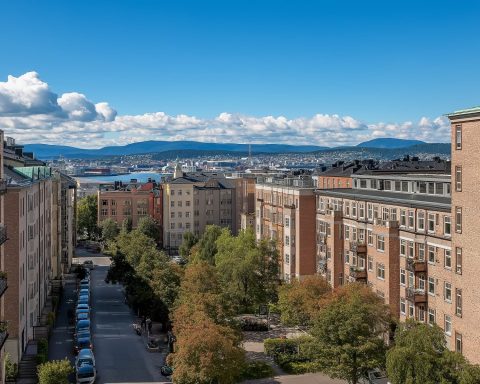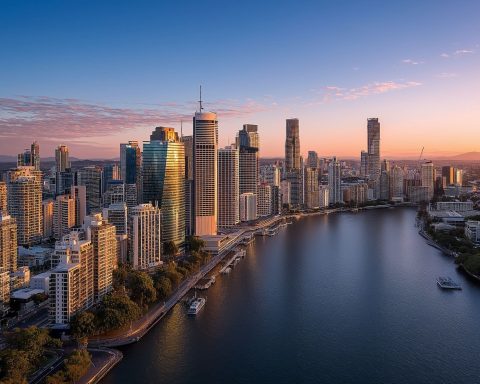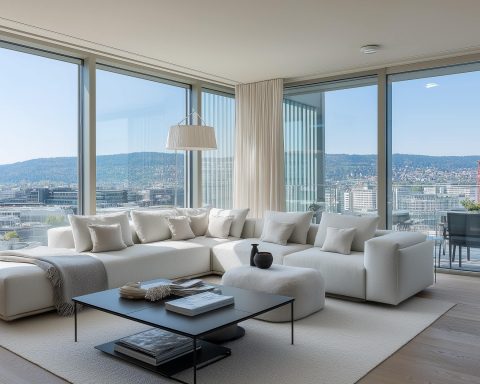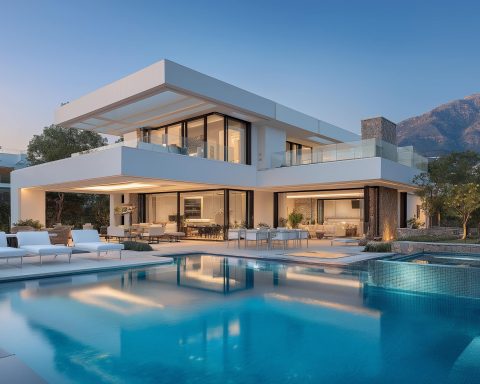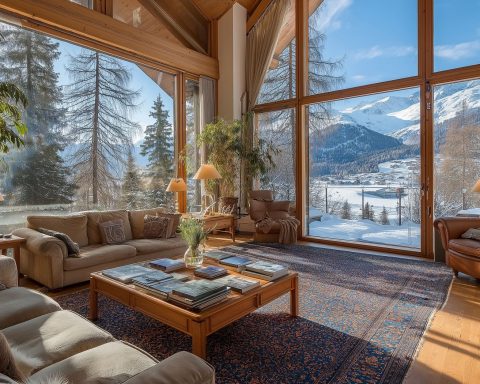Market Trends & Price Evolution (2025 & Beyond)
Méribel’s property market has been on a strong upward trajectory. Over the past five years, average prices have surged by about 51% investropa.com. As of 2025, prime residential prices in Méribel hover around €16,100 per square meter portfolio.savills.com, with standard apartments averaging roughly €10,900 per m² and chalets about €12,000 per m² investropa.com. These figures place Méribel among the priciest French ski resorts – only a notch below ultra-luxe Courchevel or Val d’Isère. In fact, exceptional ski-in/ski-out new-builds near Méribel’s slopes (e.g. around the Rond Point area) can command €20,000–€35,000 per m² portfolio.savills.com, approaching Courchevel-1850 levels. By contrast, older resale chalets in Méribel (off-piste or needing renovation) trade closer to €14,000–€17,000 per m² meribel-sothebysrealty.com, illustrating a wide range between standard and trophy properties.
Recent price growth has outpaced the broader French market. Mountain home values rose ~4.4% in 2023 on average actual-immo.fr, even as other regions slowed. Méribel itself saw about a 4.2% year-on-year increase, with an average of €10,615 per m² by late 2024 actual-immo.fr. This resilience reflects persistent demand: despite higher interest rates in 2023–24, affluent buyers continue to prioritize Alpine retreats. Forecasts for the next few years (2025–2027) predict moderate growth of ~2–3% annually, rather than another explosive jump investropa.com investropa.com. Limited new supply, combined with Méribel’s enduring appeal, should support gradual appreciation. Barring any global downturn, the 2025–2030 outlook remains positive – a “slow burn” rise in prices rather than a bubble burst investropa.com.
Rental Yields & Seasonal Occupancy
Owning in Méribel is not just about capital growth – rental income is a major draw. In peak winter weeks, nightly and weekly rates skyrocket due to intense demand. Gross rental yields of 3%–6% per year are typical in top Alpine resorts omniacapitalgroup.com, and Méribel is no exception. Luxury chalets during New Year or February holidays can fetch well into five figures per week, especially for large ski-in/ski-out properties omniacapitalgroup.com. Winter remains the cash cow: the resort’s population swells from ~2,000 in off-season to 20,000+ residents in winter meribel-sothebysrealty.com, leading to near 100% occupancy during prime ski weeks. Many owners report that 10-15 booked weeks was once the norm, but now 25-30 weeks of occupancy per year is increasingly achievable agenceboan.com – a reflection of both a longer ski season and burgeoning summer tourism.
Importantly, Méribel’s rental calendar is expanding beyond winter. Savvy investors capitalize on the growing summer market: hiking, mountain biking, and festivals are drawing more off-season visitors. For example, in Chamonix (another Alps resort) summer lift-pass sales jumped 46% in two years investropa.com – a trend mirrored in the Three Valleys region as tourists seek year-round Alpine escapes. Méribel’s ski lifts now open in summer months, boosting occupancy in July-August. This broadening of demand helps stabilize annual returns omniacapitalgroup.com. Owners who rent out in both winter and summer enjoy steadier cash flow and higher overall yield, rather than relying only on the ski season.
It’s worth noting that rental returns in ski resorts can vary widely. Properties on the piste or in the center command a premium (often above asking price when sold meribel-chalets-apartments.com, reflecting their rental desirability). Meanwhile, owners of homes in quieter hamlets may see slightly lower weekly rates but longer seasons (as summer renters favor tranquil settings). Rental strategies also differ: some owners sign up with tour operators or seasonal leases, though that model waned post-Brexit/Covid (most operators now pay per week used, not full-season upfront) meribel-chalets-apartments.com. Increasingly, owners are turning to local agencies or concierge services for weekly lettings to maximize income meribel-chalets-apartments.com. Overall, an investor can expect a solid return if they calibrate usage and pricing smartly – many aim for a balance of personal use (a few prime weeks kept for themselves) and rental weeks that cover annual costs plus yield. By targeting high-demand periods and embracing off-season bookings, Méribel landlords often find the investment “washes its face” financially and then some.
New Developments & Infrastructure Upgrades
Méribel is an established resort with charming chalet architecture, so new construction is relatively scarce – but the projects that do emerge are high-caliber. Several new developments are adding modern stock to the market between 2024 and 2026, catering to luxury buyers and investors:
- Falcon Lodge – A standout new complex of 35 apartments and chalets in Méribel Centre en.savills.fr. This residence offers five-star amenities including a private spa, swimming pool, concierge, parking and ski room. Located ~150m from the slopes, Falcon Lodge blends contemporary design with alpine elegance, embodying Méribel’s discreet luxury en.savills.fr. It has been a hit with buyers; inventories are limited as it nears completion.
- Fleur des Alpes – A 29-unit luxury residence in the Altitude 1600 area, delivered in late 2024 meribel-sothebysrealty.com meribel-sothebysrealty.com. These furnished apartments (3–4 bedrooms, ~127 m² example) come “ready-to-live” with chic modern Alpine decor. The project is situated by the Morel chairlift for convenient slope access. Notably, buyers here can recover VAT (20%) on purchase and benefit from reduced transfer taxes meribel-sothebysrealty.com by renting the units out as tourist accommodation – a French fiscal incentive for new-build ski properties. As of early 2025, only a handful of units remained available meribel-sothebysrealty.com, signaling strong demand for new builds in Méribel.
- Le Lac Bleu – A new ski-in/ski-out development of 23 apartments at Méribel Mottaret (alt. 1750m). It offers high-end flats from 2-bedroom units up to a 238 m² penthouse properties.lefigaro.com. Amenities include a wellness area with pool, gym, spa, an on-site restaurant, plus indoor parking and private ski lockers properties.lefigaro.com. Lac Bleu positions itself as a “last chance” to own a freehold new-build in the heart of Méribel, complete with VAT rebate eligibility and reduced notary fees properties.lefigaro.com. Such perks and the promise of “a good return” have attracted both lifestyle buyers and investors properties.lefigaro.com properties.lefigaro.com.
Beyond real estate developments, Méribel and the Trois Vallées are investing heavily in infrastructure upgrades to enhance the ski experience and year-round appeal. A major project underway is the replacement of the old Côte Brune chairlift (a 4-seater linking Méribel-Mottaret to Val Thorens) with a state-of-the-art 10-person panoramic gondola, slated to open in December 2025 skipassmeribelmottaret.com. This €10M lift upgrade will drastically improve speed and comfort on a key inter-valley link – no more wind-chilled slow rides up the ridge skipassmeribelmottaret.com. In the meantime, about half the construction was completed during summer 2024, with full service expected for Winter 2025/26 skipassmeribelmottaret.com.
Other recent improvements include modernizing beginner areas and lift infrastructure: the Doron magic carpet in Mottaret’s center was fitted with a weather-protective canopy for Winter 2024 skipassmeribelmottaret.com, making first-time skiing more comfortable in bad weather. New pistes and experiences are also rolling out – e.g. the newly created “Rossignol” blue run (a fun, gently banked carving piste in the Plattières sector) skipassmeribelmottaret.com, and a 5.5 km ski touring trail up from Méribel Village (Pic Bleu itinerary) for uphill skiing enthusiasts skipassmeribelmottaret.com. Méribel has even introduced “First Track” mornings, allowing keen skiers to ascend at dawn, watch sunrise from the summit, and enjoy pristine early runs before lifts officially open les3vallees.com – a sign of how the resort is diversifying its offerings.
These upgrades, along with ongoing enhancements across Les 3 Vallées (from revamped lift station designs to new family zones and even mountain solar power installations meribel.net), underscore a commitment to maintaining the area’s world-class status. For property owners, better infrastructure is a boon: faster lifts and new amenities tend to boost property values and rental appeal. Looking ahead, we can expect continued investment in modernizing lifts, expanding snowmaking, and developing four-season facilities (bike parks, alpine coasters, event venues) to secure Méribel’s future in a changing climate. The 2023 Alpine Ski World Championships (hosted in Méribel-Courchevel) saw significant resort improvements, and local authorities aim to keep that momentum going. Overall, Méribel’s “hardware” (lifts, slopes, utilities) is being steadily upgraded to match its luxury real estate – good news for both skiers and investors.
Méribel vs. Other Alpine Resorts: Price & Appeal
How does Méribel stack up against its Alpine peers? In short, it’s among the elite league of ski property markets. The table below compares Méribel to a few nearby or competing resorts in 2025:
| Resort | Avg Price – Apartments | Avg Price – Chalets | Notable Features & Market |
|---|---|---|---|
| Courchevel (3 Vallées) | ~€11,800/m² investropa.com | ~€12,100/m² investropa.com | Ultra-prime (1850 sector). Prices +15% since pandemic portfolio.savills.com; prime avg €26,600/m² portfolio.savills.com. Attracts global elite (incl. Middle Eastern buyers) portfolio.savills.com. Michelin-star dining, luxury boutiques. |
| Méribel (3 Vallées) | ~€10,900/m² investropa.com | ~€12,075/m² investropa.com | Central 3 Vallées location. Strong domestic (French) buyer base portfolio.savills.com. Prime slope-side new builds reach €20–35k/m² portfolio.savills.com. Family-friendly yet chic vibe, robust rental demand. |
| Val d’Isère (Espace Killy) | ~€11,200/m² investropa.com | ~€16,100/m² investropa.com | Exclusive, snow-sure resort. Highest chalet prices in France (many >€15k/m²) investropa.com. International cachet; limited supply keeps prices high. Strong rental yields, long season (glacier skiing). |
| Chamonix (Mont Blanc) | ~€8,400/m² investropa.com | ~€11,800/m² investropa.com | Legendary mountaineering town, 4-season resort. Prices lower than 3 Vallées, but rising. Diverse market (apartments to historic chalets). Summer tourism boom (+46% lift sales) investropa.com draws investors seeking year-round income. |
| Megève (Mont Blanc) | ~€11,000/m² (est.) collection-chalet.co.uk collection-chalet.co.uk | ~€11,000/m² (est.) | Timeless charm and luxury (popular with European jet-set). Pricing on par with Courchevel’s mid-range. Slower price growth but very stable market. Upscale amenities (boutiques, polo, fine dining) support premium values. |
Sources: Knight Frank Ski Report, Investropa, Savills, Cimalpes investropa.com collection-chalet.co.uk portfolio.savills.com. (Prices are approximate averages; specific sectors within each resort can vary significantly.)
In summary, Méribel holds its own among the top-tier French resorts. Courchevel 1850 still tops the charts for sheer price levels (and glitz), and Val d’Isère’s uber-luxury chalets can exceed Méribel’s highest by some margin. However, Méribel’s advantage is its combination of location and varied appeal: it sits in the heart of the world’s largest ski domain (offering access to Courchevel, Val Thorens, etc.) while retaining a village charm and slightly more down-to-earth atmosphere than Courchevel 1850. Savills notes that Méribel has a more predominantly French and family-oriented clientele, whereas Courchevel 1850 attracts a flashier international crowd portfolio.savills.com portfolio.savills.com.
Compared to Chamonix, Méribel is pricier but purely a ski resort (Chamonix is a real town with a big year-round population and slightly lower entry prices). Investors focused on rental yields might also compare Méribel with Tignes/Val Thorens – higher altitude resorts where prices are a bit lower but seasons longer. Notably, Val Thorens (at 2300m) scored highest on Savills’ Ski Resilience Index for snow reliability portfolio.savills.com, and its property values (≈€8k/m²) remain below Méribel’s, potentially offering value. Emerging “competitors” like Saint-Martin-de-Belleville (a quieter 3 Vallées village) are also worth mentioning – prices there have climbed to €9–11k/m² collection-chalet.co.uk as buyers seek authenticity plus 3V access, making it an “undiscovered” alternative to Méribel’s hustle. In essence, Méribel sits at the sweet spot: it’s less ostentatious (and slightly less expensive) than Courchevel, but more central and higher-end than smaller neighbors. This balance bodes well for its long-term investment desirability relative to other Alpine markets.
Buyer Profiles: Who’s Investing in Méribel?
Méribel’s real estate market attracts a mix of domestic and international buyers, with a notable skew toward high-net-worth lifestyle purchasers (vs purely speculative investors). Traditionally, the British were dominant foreign buyers – Méribel was actually founded by a Brit in the 1930s and has long been beloved by UK skiers. Post-Brexit, UK buyers remain very active, though they must navigate the 90-day stay rule for second homes. Today, French nationals form the largest group of owners in Méribel portfolio.savills.com, reflecting how many affluent French families choose Méribel for their alpine retreats. In recent years, agencies report growing interest from Belgian, Dutch, and Swiss buyers, as well as other EU nationals drawn to the Three Valleys’ reputation.
An emerging trend is the entry of some non-European investors, particularly from the US and Middle East, into the prime Alpine property segment. Industry reports in 2025 highlight “growing international interest, particularly from US buyers” in the French Alps investropa.com. A strong dollar and global search for safe-haven assets have made Alpine chalets attractive to certain American buyers who might previously have overlooked the Alps. Meanwhile, Middle Eastern buyers (who have long favored Courchevel 1850’s glamour) occasionally venture to Méribel as well, though Courchevel remains the bigger magnet for that demographic portfolio.savills.com.
Buyer motivations here skew toward lifestyle and legacy. Unlike purely investment-driven markets, most Méribel buyers intend to use the property with family and friends, at least part of the year. A typical profile might be a wealthy family from Paris, Lyon or London seeking a holiday home that doubles as an investment. These buyers value Méribel’s mix of reliable rental income and personal enjoyment. The investor vs. lifestyle buyer balance can be seen in how properties are marketed: many listings emphasize “authentic Alpine charm”, “family-friendly amenities” alongside rental potential. For example, a sales agent notes that today’s buyers ask “not only how much can I earn, but how long can I keep it, who can I share it with, how does it fit my family’s legacy?” omniacapitalgroup.com. This underscores that emotional appeal is key – owning a Méribel chalet is as much about “memory-making” as about ROI omniacapitalgroup.com.
That said, pure investors are not absent. Some buyers (often through companies or funds) target new-build apartments in Méribel for the VAT rebates and rental programs. These investor buyers, including institutional ones, look for hassle-free setups: new serviced residences with guaranteed rental management. They are attracted by the steady Alpine demand and limited supply, treating ski properties as portfolio diversifiers. There’s also a subset of value-add investors – those who buy older chalets to renovate and modernize (taking advantage of the premium for turn-key, energy-efficient homes). With ~31% of mountain homes having poor energy ratings collection-chalet.co.uk, there is opportunity for renovators to upgrade chalets to modern eco-standards and reap capital gains.
In summary, Méribel’s buyer pool in 2025 can be summarized as: affluent end-users (both French and international) for chalets, plus a savvy layer of investors for apartments/new-builds. The common thread is that all recognize Méribel’s prestige and long-term stability – whether it’s a British family cherishing alpine holidays, a Parisian executive investing his bonus into a ski apartment, or an American looking for a trophy asset in Europe. This diverse demand base has helped keep the market robust through economic cycles.
Regulatory & Legal Factors
France’s legal environment provides a generally secure and attractive framework for real estate, but there are specific regulations that Alpine property buyers and owners should note:
- Climate & Energy Regulations: A major new factor is France’s Climate and Resilience Law (“Loi Climat et Résilience”), which targets energy inefficiency. Starting January 2025, residential properties with an energy rating of ‘G’ (the worst band) can no longer be legally rented out in France, and ‘F’ ratings face the same ban by 2028 collection-chalet.co.uk. In the Alps, many older chalets are poorly insulated “passoire thermique” (energy sieves), so this law is significant. Owners in Méribel are scrambling to upgrade insulation, heating systems, and windows to improve their DPE (Diagnostic de Performance Énergétique) ratings. Not only is this crucial for anyone planning to do seasonal rentals, but it also affects resale value – energy-efficient chalets are now in higher demand (and can command a “green premium”), while outdated ones might require a price discount or renovation plan. Local agencies are advising buyers on this; for instance, some new-build programs market their eco-friendly credentials to meet modern standards actual-immo.fr. Overall, the push for sustainability is reshaping the market: expect more solar panels on chalet roofs, better insulation, and possibly government incentives for retrofits in ski areas.
- Rental Rules & Taxation: If you plan to rent out your Méribel home, there are specific rules. Short-term rentals (Airbnb-style) in tourist zones are generally permitted, but you must register and pay the “taxe de séjour” (visitor tax) to the local mairie. Méribel (Les Allues) authorities require owners to declare their rental and collect this small per-night tax from guests taxedesejour.ofeaweb.fr. On the tax front, France offers an attractive carrot: owners who buy new resort property and commit to renting with hotel-like services can reclaim the 20% VAT on the purchase price meribel-sothebysrealty.com. This is why many new builds advertise a VAT-inclusive and ex-VAT price. Additionally, new-build purchases incur lower notary fees (~2–3%) versus ~7–8% on resales investropa.com, a significant saving. These incentives effectively encourage investment in tourist residences. Conversely, holding a property has its costs: second-home owners still pay taxe d’habitation (habitation tax) annually (unlike primary residences, which are mostly exempt now) e-immobilier.credit-agricole.fr. Some mountain communes have even hiked this tax for vacant second homes to nudge owners into renting them out and keeping beds “warm” for tourist use – an issue to watch as Alpine communities seek more year-round occupancy.
- Foreign Buyer Access: Unlike Switzerland or Austria, France imposes no restrictions on foreign buyers purchasing in ski resorts. EU citizens face no special hurdles; post-Brexit Britons and other non-EU nationals can also buy freely (though they need a visa for stays beyond 90 days). Owning property does not grant residency rights, but many non-resident owners simply enjoy their allotted visa-free periods or apply for longer-term visas if needed. Financing is available: French banks do lend to foreign buyers, albeit with stricter conditions recently (interest rates in 2024 rose and banks have shown caution). Still, many Alpine purchases are cash transactions given the wealthy profile of buyers.
- Local Planning & Architecture Rules: Méribel is known for its harmonious chalet-style architecture – this is no accident. The resort has strict planning regulations (Loi Montagne) that mandate traditional building materials (wood, stone, sloped roofs) and limit high-rise development. Don’t expect any concrete tower blocks here. For buyers, this means the aesthetic of the resort (and thus property values) is protected, but also that constructing a new chalet or extending an existing one requires navigating local building codes. Land for development is limited by zoning and national park boundaries, preserving scarcity.
- Legal Process: Property transactions in France are handled by notaries (state-appointed lawyers) who ensure clear title and handle all paperwork. Foreign buyers should budget ~7–8% for closing costs on resale properties (inclusive of notary fees and taxes). One quirk in resorts: if buying through a leaseback or from a developer, read the contract for any rental obligations (some new-build sales require you to rent out for a certain number of weeks to keep the VAT rebate). Also, be aware of co-ownership bylaws when buying an apartment – condos in Méribel may have rules on short-term subletting, renovations, etc., set by the syndic (HOA). It’s advisable to work with an agent experienced in the French Alps, as they’ll highlight these nuances (several agencies even publish guides on the buying process specific to Méribel meribel.net).
In essence, France offers a stable legal environment for property owners – strong title security, no ownership quotas, and decent tax perks for investors. The newest challenges on the horizon are environmental regulations aimed at making Alpine housing greener. Savvy investors will factor in upgrade costs for older properties or lean towards turnkey new builds that meet all standards.
Market Outlook & Investment Potential (2025–2030)
Looking ahead to the medium term, the Méribel property market appears poised for sustained, albeit calmer, growth. Analysts predict Alpine real estate will “remain resilient” through 2030, supported by enduring demand and the lifestyle shifts that emerged post-2020. Key factors informing the outlook:
- Year-Round Demand to Buffer Winter Volatility: A fundamental shift is underway from purely winter ski demand to year-round alpine living investropa.com omniacapitalgroup.com. Remote work and lifestyle changes mean more people using their mountain homes outside the ski season. Méribel, with investments in summer infrastructure (lifts for hikers, mountain biking trails, family activities), is transforming into a dual-season resort. This should smooth out rental incomes and keep the resort vibrant beyond the traditional winter peak. A more stable, 12-month economy bolsters property values – owners can credibly plan for rental income even in shoulder seasons, and local businesses stay open, making Méribel attractive for longer stays.
- Limited Supply = Inherent Support: Méribel has very constrained development potential. It sits within the Vanoise National Park vicinity and has strict building quotas. New plots are rare; most future supply will come from redeveloping older buildings rather than expanding into virgin land. This scarcity underpins prices. Supply constraints, combined with the resort’s cachet, act as a hedge against any major price correction. Even if broader French real estate cools, Méribel’s luxury segment tends to hold value due to the “trophy asset” nature – much like how central Paris or London prime property resists downturns. Knight Frank’s research has highlighted that prime Alpine markets weathered recent global challenges (prices in the French/Swiss Alps rose ~13.9% during the pandemic years) content.knightfrank.com. Méribel’s stable, high-net-worth ownership base suggests low distress sales and steady long-term appreciation.
- Macro Factors: The period to 2030 will likely see fluctuations in interest rates, inflation, and possibly taxation. However, many expect European interest rates to stabilize or fall slightly by 2025–2026, which could re-energize buyer activity after a cautious 2023–24. Meanwhile, inflation might actually encourage investment in real assets like property as a hedge. One thing to watch is the global economy: a severe recession could dent second-home purchases, but so far the luxury alpine segment has proven remarkably insulated. The weakness of the euro vs. dollar or franc can also influence demand – e.g. Americans and Swiss find French property “on sale” during euro dips. France’s political climate and any new wealth taxes could affect ultra-rich buyers, but no dramatic measures are foreseen at the moment (recently, France has trended toward removing wealth taxes on real estate and focusing on other levies).
- Climate Change & Resort Viability: By 2030, climate impacts may start to be felt more acutely. Méribel’s base elevation (1400 m) is relatively secure for now (and its ski area connects up to 3000+ m in Val Thorens), but lower resorts might struggle with snow reliability. The Three Valleys as a whole is investing in snow-making and “snow farming” to guarantee ski seasons into spring. If climate trends worsen, high-altitude resorts (like Val Thorens) could gain favor over lower ones – fortunately, Méribel has access to those slopes via lifts. Additionally, climate awareness might increase demand for eco-friendly homes, as mentioned. Méribel is better positioned than many resorts due to its altitude range, but it will need to continue diversifying activities (e.g. more emphasis on summer and even autumn tourism) to remain a top-tier destination in the 2030s. The outlook assumes the resort will adapt, and given current initiatives (from sustainability programs to events like summer music festivals), Méribel is proactively safeguarding its future.
- Investment Thesis: Over 2025–2030, investing in Méribel real estate is widely seen as a sound long-term bet, especially for those with a 5+ year horizon and dual usage intent. Capital appreciation is expected to be steady (low-to-mid single digits annually investropa.com), not speculative spikes. When combined with rental yields (~3-5%), the total return is attractive compared to ultra-low-yield bonds or volatile equities. Moreover, the lifestyle dividend – the enjoyment of the asset – is a non-monetary return that’s highly valued by owners. By 2030, we anticipate Méribel will remain in the “Top 5” of French ski markets by price, with a possibility of narrowing the gap with Courchevel as ultra-prime new projects (like those €30k/m² slope-side residences) set new benchmarks. External risks (pandemics, travel restrictions) appear to be receding; in fact, the pandemic actually boosted interest in spacious, natural retreats like Alpine chalets. If anything, global uncertainty has reinforced the notion of “buy tangible, buy what you love”, which plays into Méribel’s hand.
In conclusion, the medium-term market outlook for Méribel is positive and balanced. Don’t expect the dizzying price jumps of the past decade to repeat at the same pace – but do expect Méribel to continue being a blue-chip alpine property market, offering both reliable returns and an idyllic alpine lifestyle as dividends.
Property Types Breakdown: Chalets, Apartments, Ski-in/Ski-out & Commercial
Méribel’s property market can be segmented into a few key property types, each with its own characteristics, typical buyers, and investment profile:
- Luxury Chalets: The quintessential Méribel property – independent chalets (often wooden-clad, with stone foundations and slate roofs) – represents the top of the market. Chalets in Méribel range from ~€2 million for a modest older chalet up to €10–€20+ million for ultra-luxe homes in the best locations portfolio.savills.com portfolio.savills.com. They offer privacy, spacious living, and often land (a rarity in ski resorts). Typical chalet buyers are wealthy families or individuals looking for a trophy second home (or relocating for part of the year). These properties emphasize lifestyle: fireplaces, wellness areas (sauna, pool, hot tub), cinema rooms, and expansive terraces with views are common asks at the high end portfolio.savills.com. Investment-wise, chalets can yield good weekly rents (large groups pay a premium for standalone chalets with 5+ bedrooms), but they also entail higher running costs (maintenance, heating, landscaping, etc.). The price per square meter for prime chalets is higher than for apartments due to scarcity – as noted earlier, new high-end chalets often exceed €17k/m² meribel-sothebysrealty.com, with record sales even at €25k–€28k/m² for “no expense spared” builds meribel-sothebysrealty.com. For buyers seeking prestige and long-term legacy value, chalets are the go-to. They also tend to appreciate well in Méribel’s market, especially if they’re ski-in/ski-out or in central positions.
- Apartments & Condominiums: Méribel offers a large selection of apartments, from petite studios up to lavish duplex penthouses. Many are in chalet-style residences (2–5 stories), as high-rises are not allowed. Apartments are the entry point for many investors, with prices starting around the €300k-€500k range for a one-bedroom in the valley, rising to several million euros for large new units. Apartments have the advantage of “lock-and-leave” convenience and easier rental management. Yields on apartments can be strong, since demand for 2-3 bedroom family flats in good locations is very high every ski season. New-build apartments also come with modern energy standards (important for rentals) and amenities like elevators, parking, and sometimes shared wellness facilities. Investors often prefer apartments in managed residences where a rental agency or concierge is on-site to handle check-ins and maintenance – truly hands-free investing. On the other hand, owners must factor in co-owner charges (condo fees) for building upkeep. In Méribel, apartments are popular both with pure investors (looking at rental return, relatively lower cost) and with younger lifestyle buyers who may not afford a chalet yet but want a foothold in the Alps. The average apartment price ~€10-11k/m² investropa.com means a 50 m² two-bedroom can easily run €500k+, but these units remain highly liquid in the market because of broad demand.
- Ski-In/Ski-Out Properties: Whether chalet or apartment, ski-in/ski-out units deserve special mention. These are properties directly on or adjacent to the pistes, allowing one to ski directly from the door. In Méribel, such properties, especially near La Chaudanne (main lifts hub) or along the Doron piste and Rond Point area, command a significant premium. They are the first to be booked by renters and often see fierce bidding from buyers. One source notes “prized properties on the piste often sell for above asking prices” meribel-chalets-apartments.com. Ski-in/out apartments can fetch higher nightly rates (renters will pay extra for true doorstep skiing convenience). From an investment standpoint, if you can snag a ski-in/out property, it’s almost a guarantee of high occupancy and strong resale value. However, expect to pay more upfront: the Savills Ski Report indicated new slope-adjacent builds in Méribel hit €20k+ per m² portfolio.savills.com, well above averages. Essentially, location on the snow = gold. For buyers prioritizing rental yield, stretching the budget for a ski-in/out location often makes sense in the long run.
- New-Build vs. Resale: Another way to categorize is by new-build (VEFA) properties versus older resales. New-build developments in Méribel (like those described earlier) offer advantages such as 10-year construction warranties, modern designs, underground parking, and today’s tech (smart home systems, etc.). They also allow for VAT rebates if managed in rental programs meribel-sothebysrealty.com. Investors who want a turnkey, hassle-free property lean toward these, as do buyers concerned about energy efficiency and maintenance. Resale properties, especially those built in the 1980s-2000s, might lack some modern flair but often come at slightly lower prices per m² and with the possibility of renovation upside. Some savvy buyers purchase dated apartments in Méribel’s older residences and renovate them to contemporary alpine-chic style, instantly increasing rental appeal and value. Given the high demand, both routes (new vs. old) can be profitable; it boils down to whether one prefers a shiny new product or is willing to do improvements.
- Commercial Spaces: While the residential sector dominates, Méribel does have a modest commercial real estate segment – mainly shops, restaurants, hotels, and hospitality businesses in the resort core. Owning commercial property in Méribel can be lucrative (high tourist footfall and affluent clientele). However, supply is extremely limited; the village has a fixed number of retail units (ski shops, bakeries, bars, etc.), and many are long-time family businesses or owned by larger chains. Occasionally, a storefront or restaurant space comes up for sale, but investors should be cautious: commercial leases in France have different rules and often long durations. The yield on commercial property might be higher on paper than residential (since businesses pay good rent to be in prime resort locations), but finding a tenant off-season can be challenging if the business is seasonal. One issue raised by local observers is a “lack of shops for locals and year-round life” in Méribel’s center – many businesses cater only to winter tourists lemonde.fr. This points to a structural challenge: as real estate gets pricier, there’s pressure on local commerce and housing for seasonal workers. The local council has even discussed measures to encourage more year-round commerce (and housing for employees) so the resort isn’t a “ghost town” in spring and fall. For an investor, buying a hotel or retail unit in Méribel is a specialized play – often done by those already in the hospitality industry. It’s notable that hotel investment in ski resorts has been growing; France saw about €2.5 billion in hotel transactions in 2023 and rising into 2025 costar.com, as professional investors see the potential. Méribel has a handful of 5-star hotels and new luxury tourist residences – a sign that institutional money is also flowing into this market segment. In summary, while residential chalets and apartments are the focus for most buyers, the commercial side (shops/hotels) is an important piece of Méribel’s ecosystem, albeit one that requires expertise to navigate.
Neighborhoods & Sectors: Méribel Centre vs. Mottaret vs. Village
Méribel is not one monolithic market – it’s composed of several distinct sectors/villages up and down the valley, each with its own character and price dynamics. Here’s a quick tour of Méribel’s key neighborhoods and how they differ in real estate:
- Méribel Centre (Altitude ~1450m): This is the bustling heart of the resort, comprising areas like La Chaudanne, Route de la Montée, and the upper Centrum around 1600m (Rond Point). Méribel Centre is where you find the main lifts, ski school, shops, restaurants, and nightlife. Properties here (whether apartments or chalets) are in highest demand due to walking proximity to amenities and slopes. Expect premium pricing – a convenient 3-bedroom apartment in Méribel Centre can easily exceed the price of a similar unit in a peripheral village. According to Savills, prime new-builds near the center (e.g. around Le Rond Point) are among the most expensive, hitting €30k+ per m² portfolio.savills.com for the best units. The Centre has a mix of large chalet-style buildings (with multiple flats) and individual chalets tucked on side roads. Rental occupancy is virtually guaranteed here, as most tourists want to be in the center. However, the buzz comes with a trade-off: it’s livelier and busier. For buyers seeking peace, the center might feel too crowded in peak season. Still, investment-wise, you cannot go wrong with a well-located property in Méribel Centre – liquidity is high, and there’s always demand for this location. Recent infrastructure like the escalator from the upper part of town to La Chaudanne base area has further improved convenience, making Centre properties even more attractive.
- Méribel-Mottaret (1750m): Often just called Mottaret, this is a purpose-built high-altitude village at the top of Méribel Valley. Mottaret offers superb ski-in/ski-out convenience – many apartment blocks and some chalets are right on the slopes (the village is surrounded by ski runs). Because it was mainly developed in the 1970s-80s, architecture in Mottaret is more functional (less quaint) – think apartment residences with a modern alpine style. Mottaret is quieter in terms of nightlife (fewer shops and bars, though it has enough restaurants for residents), and it appeals strongly to die-hard skiers who prioritize being first on the lifts. Prices in Mottaret have historically been slightly lower than Méribel Centre for older properties, but the gap is closing as any ski-in/out property gains value. Newer luxury developments like Lac Bleu in Mottaret show that high-end demand exists here too, not just in the Centre. The advantages of Mottaret include a longer season (its higher elevation means you can often ski back to your door later in spring) and spectacular views over the Tuéda lake and Vanoise peaks. Buyers who are investors first, vacationers second might favor Mottaret for its efficiency: you get more snow certainty and generally better price-to-ski-access ratio. A note on atmosphere: Mottaret is smaller and can feel more tranquil (or isolated, depending on perspective) – there’s a free shuttle and lift connection down to Méribel Centre for those craving more village charm.
- Méribel Village & Les Allues: Méribel Village (at ~1400m) and Les Allues (1100m, further down valley) are the more authentic Savoyard communities. Méribel Village is a small, postcard-esque hamlet 2km from Méribel Centre, featuring traditional chalets, a village bakery, a couple of restaurants, and the Golf chairlift linking into the ski area. It’s very popular with families and those seeking a quieter base; property here often consists of charming chalets and a few tasteful apartment residences (like the recent “Le Hameau des Cîmes”). Prices in Méribel Village are a bit lower than in the Centre – you might find €8k-9k per m² for some properties – yet it offers direct ski access (albeit via one lift). Les Allues is the original historic village down in the valley (the administrative center of the commune). It’s a true year-round village with local residents, a school, and more affordable housing. Allues is connected to Méribel by an Olympe gondola (and roads), so you can ski down close to it in winter or take the lift. Real estate in Les Allues is the most affordable in the Méribel area; it appeals to those who want a foothold in 3 Vallées but are okay with a short lift or drive to the main resort. For example, a cozy apartment or village house in Les Allues will cost significantly less per m² than one up in Méribel Centre. These areas are great for value-seekers and also offer a more authentic community feel – something that can boost off-season rental prospects (e.g., seasonal workers or long-term summer lets often stay in Allues). Savills notes that one’s “budget stretches further in the original Méribel Village/Les Allues or hamlets like Le Raffort” portfolio.savills.com portfolio.savills.com, emphasizing their relative affordability.
- Le Raffort & Other Hamlets: Besides the main villages, Méribel has several hamlets (Le Raffort, Vanthier, Chandon, etc.) scattered on the road up the valley. Le Raffort is particularly noteworthy: a quaint hamlet just below Méribel Centre, it has its own gondola stop (L’Olympe mid-station) and even a ski route down to it (when snow permits). Le Raffort features beautifully restored farmhouses and new luxury chalets that blend into the old farming village aesthetic. It’s become something of a hotspot for chalet buyers who want tranquility and authenticity yet quick access to Méribel’s slopes (you can hop the gondola up in minutes). Property in Le Raffort is priced around the same level as Méribel Village – premium, but not as high as the Centre. Meanwhile, hamlets like Chandon or Nantgerel are lower down, mostly residential, offering some good “secret deals” for those willing to commute 10 minutes to the lifts. These micro-markets are small but can be hidden gems – for instance, an investor might renovate an old barn in a hamlet into a luxury chalet at a lower land cost, banking on the allure of a “secluded alpine retreat”.
To summarize the neighborhood breakdown: Méribel Centre = convenience and prime prices; Mottaret = altitude and ski-in/out practicality (with slightly more 70s architecture); Village/Allues = charm and value, with a short distance trade-off; Hamlets = rustic calm and niche opportunities. All are within the Méribel umbrella and benefit from the common ski area, but your experience (and price point) will differ. Smart buyers match their priorities with the locale: if you want lively après-ski and walk-to-everything, aim for Centre; if you want ski convenience and don’t mind a purpose-built feel, Mottaret is ideal; if you seek peace, tradition, or a tighter budget, the lower villages shine. This diversity within Méribel is actually one of its strengths – there’s something for everyone, which broadens the market and keeps it dynamic. As one developer put it, Méribel offers “intimate villages and cutting-edge amenities perfectly integrated”, allowing each sector to retain unique appeal while still part of the larger resort cimalpes.com. From an investment perspective, all these sectors benefit from Méribel’s brand; choosing one over another is more about personal use case and target clientele for rentals.
Sources: This report draws on data and insights from leading real estate agencies and market research in the Alps, including Knight Frank’s Alpine Property Report investropa.com investropa.com, Savills ski market analyses portfolio.savills.com portfolio.savills.com, Investropa’s 2025 French Alps property review investropa.com investropa.com, as well as local experts (Free Spirit Alpine, Cimalpes, Sotheby’s) and French publications collection-chalet.co.uk actual-immo.fr. All statistics and citations are provided to ensure transparency. Méribel’s real estate market in 2025 sits at an exciting juncture – buoyed by recent growth, adapting to new trends, and poised for a sustainable future as a flagship resort. Whether you’re an investor eyeing rental yields or a skier dreaming of a chalet in the snow, Méribel continues to offer a compelling proposition in the French Alps’ property landscape. investropa.com portfolio.savills.com
